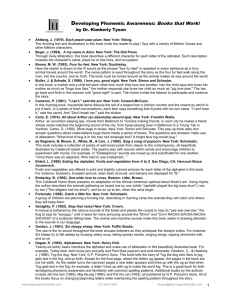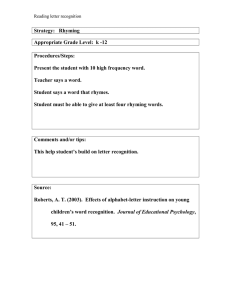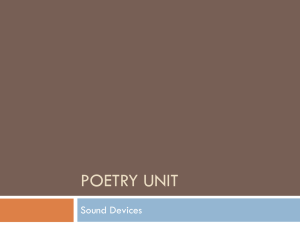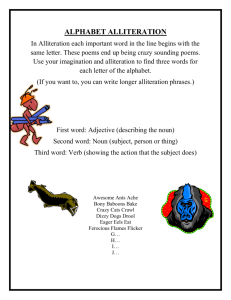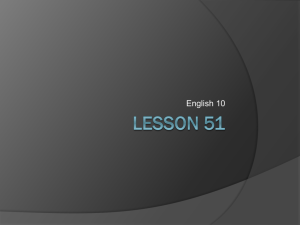Children's Books for Teaching Phonemic Awareness
advertisement
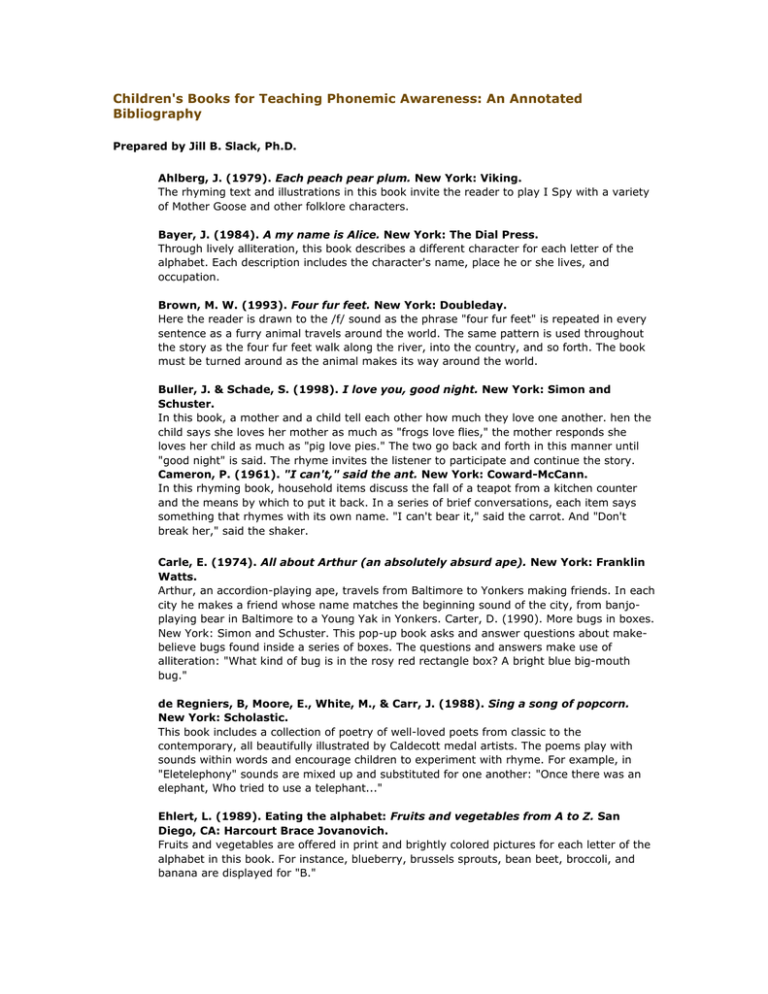
Children's Books for Teaching Phonemic Awareness: An Annotated Bibliography Prepared by Jill B. Slack, Ph.D. Ahlberg, J. (1979). Each peach pear plum. New York: Viking. The rhyming text and illustrations in this book invite the reader to play I Spy with a variety of Mother Goose and other folklore characters. Bayer, J. (1984). A my name is Alice. New York: The Dial Press. Through lively alliteration, this book describes a different character for each letter of the alphabet. Each description includes the character's name, place he or she lives, and occupation. Brown, M. W. (1993). Four fur feet. New York: Doubleday. Here the reader is drawn to the /f/ sound as the phrase "four fur feet" is repeated in every sentence as a furry animal travels around the world. The same pattern is used throughout the story as the four fur feet walk along the river, into the country, and so forth. The book must be turned around as the animal makes its way around the world. Buller, J. & Schade, S. (1998). I love you, good night. New York: Simon and Schuster. In this book, a mother and a child tell each other how much they love one another. hen the child says she loves her mother as much as "frogs love flies," the mother responds she loves her child as much as "pig love pies." The two go back and forth in this manner until "good night" is said. The rhyme invites the listener to participate and continue the story. Cameron, P. (1961). "I can't," said the ant. New York: Coward-McCann. In this rhyming book, household items discuss the fall of a teapot from a kitchen counter and the means by which to put it back. In a series of brief conversations, each item says something that rhymes with its own name. "I can't bear it," said the carrot. And "Don't break her," said the shaker. Carle, E. (1974). All about Arthur (an absolutely absurd ape). New York: Franklin Watts. Arthur, an accordion-playing ape, travels from Baltimore to Yonkers making friends. In each city he makes a friend whose name matches the beginning sound of the city, from banjoplaying bear in Baltimore to a Young Yak in Yonkers. Carter, D. (1990). More bugs in boxes. New York: Simon and Schuster. This pop-up book asks and answer questions about makebelieve bugs found inside a series of boxes. The questions and answers make use of alliteration: "What kind of bug is in the rosy red rectangle box? A bright blue big-mouth bug." de Regniers, B, Moore, E., White, M., & Carr, J. (1988). Sing a song of popcorn. New York: Scholastic. This book includes a collection of poetry of well-loved poets from classic to the contemporary, all beautifully illustrated by Caldecott medal artists. The poems play with sounds within words and encourage children to experiment with rhyme. For example, in "Eletelephony" sounds are mixed up and substituted for one another: "Once there was an elephant, Who tried to use a telephant..." Ehlert, L. (1989). Eating the alphabet: Fruits and vegetables from A to Z. San Diego, CA: Harcourt Brace Jovanovich. Fruits and vegetables are offered in print and brightly colored pictures for each letter of the alphabet in this book. For instance, blueberry, brussels sprouts, bean beet, broccoli, and banana are displayed for "B." Emberley, B. (1992). One wide river to cross. Boston: Little, Brown. This Caldecott Honor Book presents an adaptation of the African-American spiritual about Noah's ark. Using rhyme, the author describes the animals gathering on board one by one (while "Japhelth played the big bass drum"), two by two ("The alligator lost his shoe"), and so on up to ten, when the rains begin. Fortunata. (1968). Catch a little fox. New York: Scholastic. A group of children are planning a hunting trip, describing in rhyming verse the animals they will catch and where they will keep them. Geraghty. P. (1992). Stop that noise! New York: Crown. A mouse is bothered by the various sounds of the forest and pleads the cicada to stop its "zee-zee-zee-zee," the frog to stop its "wooppp," until it hears far more annoying soundsthe "Brrrm" and "Crrrrr RACKA-DACKA-RACKA- SHOONG" of a bulldozer felling trees. The animal and machine sounds make this book useful in drawing attention to the sounds in our language. Gordon, J. (1991). Six sleepy sheep. New York: Puffin Books. The use of the /s/ sound throughout the book amuses listeners as they anticipate the sheep's antics. For instance: Six sheep try to fall asleep by slurping celery soup, telling spooky stories, singing songs, sipping simmered milk, and so on. Hague, K. (1984). Alphabears. New York: Henry Holt. Twenty-six teddy bears introduce the alphabet and make use of alliteration in this beautifully illustrated book. For example, Teddy bear John loves jam and jelly and Pam likes popcorn and pink lemonade. Hawkins, C., & Hawkins, J. (1986). Tog the dog. New York: G.P. Putnam's Sons. This book tells the story of Tog the dog who likes to jog, gets lost in the fog, and so forth. Except for the final page, where the letters og appear, the pages in the book are not full width. As the reader turns the narrower pages a new letter appears and lines up with the og so that when Tog gets lost in the fog, for example, a letter f lines up with og to make the word fog. This is a great book for both developing phonemic awareness and familiarity with common spelling patterns. Additional books by the authors include Jen the hen (1985), Mig the pig (1984), and Pat the cat (1993), all published by G.P. Putnam's Sons. All of the books focus on changing beginning letters while maintaining the spelling pattern throughout the story. Hymes, L. & Hymes, J. (1964). Oodles of noodles. New York: Young Scott Books. In this collection of poems, words both rhyme and make use of the same initial sounds in order to create nonsense words to complete the verse. Kuskin, K. (1990) Roar and more. New York: HarperTrophy. The poems and pictures in this book portray the sounds that animals make. Both the use of rhyme and presentation of animal sounds ("Ssnnaaaarrll" for the tiger, "Hsssssss..." for the snake) draw children's attention to the sounds. Lewison, W. (1992). Buzz said the bee. New York: Scholastic. In this simple book, a series of animals climb on top of one another. Before each animal sits on top of the next, it does something that rhymes with the animal it approaches. For instance, the hen dances a jig before sitting on the pig, the pig takes a bow before sitting on the cow, and so on. Martin, B. (1974). Sounds of a powwow. New York: Holt, Rinehart, & Winston. This volume includes the song "K-K-K-Katy." The first consonant of several words is isolated and repeated, as is the song title. Obligado. L. (1983). Faint frogs feeling feverish and other terrifically tantalizing tongue twisters. New York: Viking. For each letter of the alphabet, at least one tongue twister using alliteration is presented in print with humorous pictures. For instance, S shows smiling snakes sipping strawberry sodas, a shy spider spinning, and a swordfish sawing. T has two toucans tying ties, turtles tasting tea, and tigers trying trousers. Parry, C. (1991). Zoomerang-a-boomerang. Poems to make your belly laugh. New York: Puffin Books. Predictable and humorous rhyme patterns are present in nearly all of the poems in this collection. For instance, in the poem, "Oh my, no more pie," the meat's too red, so the writer has some bread. When the bread is too brown, the writer goes to town, and so forth. Patz, N. (1983). Moses supposes his toeses are roses. San Diego, CA: Harcourt Brace Jovanovich. This book presents seven rhymes, each of which plays on language to engage the listener. Alliteration makes "Betty Botter" a tongue twister: "But a bit of better butter that will make my batter better!" Rhyme is predictable in " Sweetie Maguire" when she cries "Fire! Fire!" and Mrs. O'Hair says, " Where? Where?" Assonance adds humor to "The tooter" when the tooter tries to tutor two tooters to toot! Pomerantz, C. (1993). If I had a paka. New York: Mulberry. Attention is drawn to phonemes when languages other than English are introduced. Eleven languages are represented among the12 poems in this book. The Vietnamese translation of the following draws attention to rhyme and repetition: I like fish, Toy tik ka; I like chicken, Toy tik ga; I like duck, Toy tik veet; I like meat, Toy tik teet. Prelutscky, J. (1989). Poems of A. Nonny Mouse. New York: Alfred A. Knopf. In this humorous selection of poems, A Nonny Mouse finally gets credit for all her works that were previously attributed to "Anonymous." Of special interest for developing phonemic awareness are poems such as "How much wood would a woodchuck chuck" and "Betty Botter bought some butter." Raffi. (1987). Down by the bay. New York: Crown. Music is included in this selection in which two young children try to outdo one another in making up rhymes with questions like, "Did you ever see a goose kissing a moose, a fly wearing a tie, or llamas eating pajamas down by the bay?" Rogers, P. (1990). What will the weather be like today? New York: Greenwillow Books. In this entertaining book, animals and humans discuss, in rhyming verse, the possibility of the day's weather. Rothman, J. (1979). This can lick a lollipop. Body riddles for kids. Garden City, NY: Doubleday. Presents riddles and rhyme about various parts of the human body (both Spanish and English texts available). Serfozo, M. (1988). Who said red? New York: M.K. McElderry Books. A dialogue between two speakers, one of whom must keep insisting on an interest in the color red, introduces that color as well as green, blue, yellow, and others. Seuss, Dr. (1991). Dr. Seuss's ABC (2nd ed.). New York: Random House. The antics of silly nonsense characters are described in this book in which each letter of the alphabet is presented with an amusing sentence made up mostly of words that begin with the targeted letter. In one instance, "Many mumbling mice are making midnight music in the moonlight...mighty nice." Seuss, Dr. (1965). Fox in socks. New York: Random House. Tricky language play is the focus of this fun book in which the reader is warned to proceed slowly because the fox will try to tip up the reader's tongue. Assonance patterns occur throughout and the listener is exposed to subtle vowel changes when beetles battle, ducks like lakes, and ticks and clocks get mixed up with the chicks and tocks. Seuss, Dr. (1974). There's a wocket in my pocket. New York: Random House. A child talks about the nonsense creatures he has found around the house ("bofa on the sofa" and "zamp in the lamp") in this wonderful book of language play, which substitutes initial sounds of common household object to create the nonsense. Shaw, N. (1989). Sheep on a ship. Boston: Houghton Mifflin. This book describes the adventures of some sheep that go on a trip aboard a ship. The reader is drawn to the use of rhyme (waves lap and sails flap), alliteration (sheep on a ship), and assonance ("It rains and hails and shakes the sails"). Sheep in a jeep (1986), by the same author and publisher, also uses a rhyming verse to record the crazy adventures of a group of sheep that go riding in a jeep. Silverstein, S. (1964). A giraffe and a half. New York: Harper Collins. Silverstein uses cumulative and rhyming patterns to build the story of a giraffe who has a rose on his nose, a bee on his knee, some glue on his shoe, and so on until he undoes the story by reversing the events. Tallon, R. (1979). Zoophabets. New York: Scholastic. Lively alliteration describes a fictional animal for each letter of the alphabet, including where it lives and what it eats. "Runk" lives in "rain barrels" and eats "raindrops, rusty rainbows, ..." Van Allsburg, C. (1987). The Z was zapped. Boston: Houghton Mifflin. Each letter of the alphabet is involved in some alliterative mishap such as A is crushed by an avalanche, B is badly bitten, C is cut to ribbons, and so forth. Other Alphabet books using alliteration include G. Base's Animalia (1987) published by Harry N. Abrams and J. Patience's (1993) An amazing alphabet, published by Random House. Winthrop, E. (1986). Shoes. New York: HarperTrophy. This book takes a look at many different kinds of shoes and invites participation and creative contributions through the use of rhyme and rhythm. The book begins, "There are shoes to buckle, shoes to tie, shoes too low, and shoes too high." A while later we discover, "Shoes for fishing, shoes for wishing, rubber shoes for muddy squishing." Zemach, M. (1976). Hush, little baby. New York: E. P. Dutton. In this traditional rhyming lullaby, parents attempt to quiet a crying baby through the promise of many outrageous things, including a mockingbird, diamond, billy goat, and others. The verse is set to rhyme, e.g., "If that cart and bull turn over, Poppa's gonna buy you a dog named Rover," and children can easily innovate on the rhyme and add to the list of items being promised. Ziefert, H. & Brown, H. (1996). What rhymes with eel? New York: Penguin. In this simple word and picture flap book, rhyming words are linked to rhyming pictures, allowing children to predict what is under the flap.
